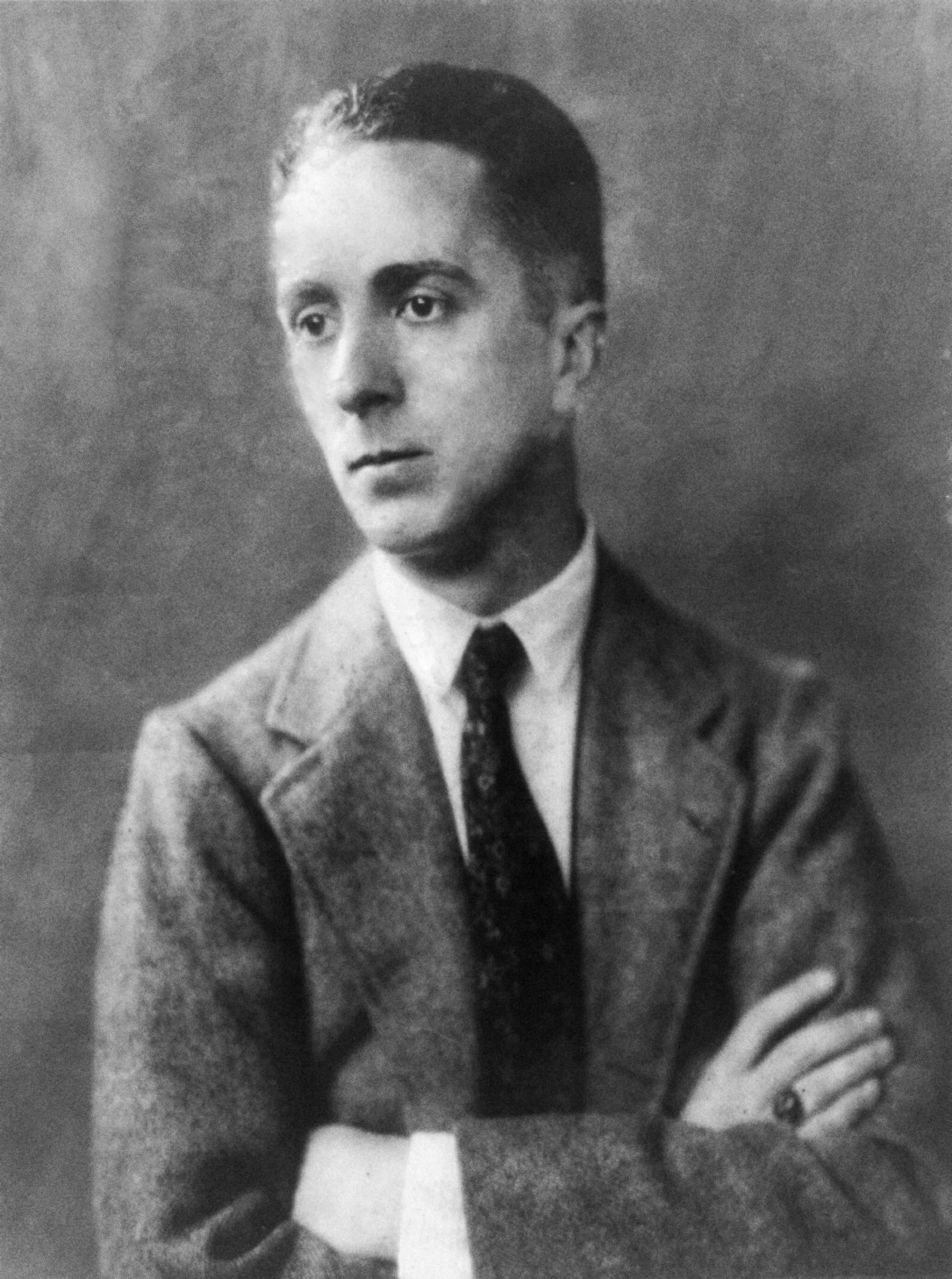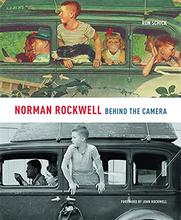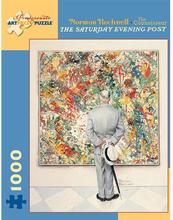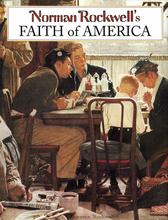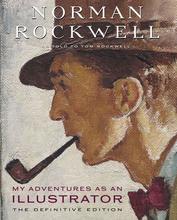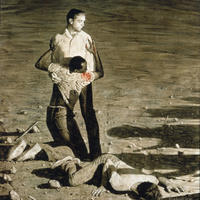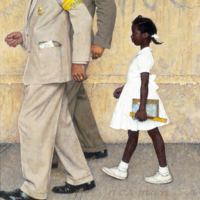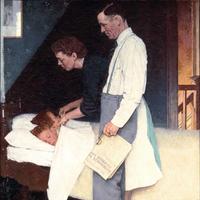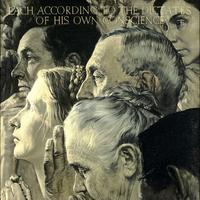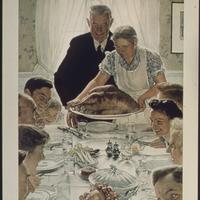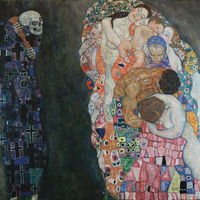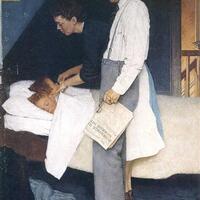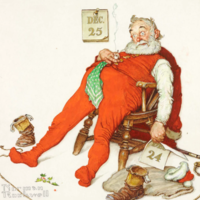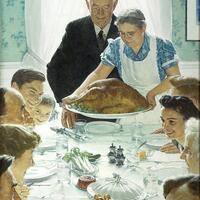More about Norman Rockwell
- All
- Info
- Shop
Works by Norman Rockwell

Contributor
Norman Rockwell was the guy that painted all those portraits of 1950s American bliss.
Born in 1894 in New York City, Norman Rockwell illustrated the patriotism, comfort, and idealism of the American dream and suburban happiness…despite the fact that he never truly felt it himself. Rockwell was married three times and none of the marriages were a sweeping success. He said about his first wife, Irene O’Connor, “After we’d been married awhile I realized that she didn’t love me.” After 14 years of a childless and apparently loveless marriage, they divorced. Rockwell married again soon thereafter, this time to Mary Barstow. Mary was 22 at the time and they had been acquainted for a grand total of two weeks before they got hitched. They had three children and seemed to have overcome that whole not loving each other thing until Mary got sick. She had gotten tired of her husband working all the time and turned to alcohol and cigarettes to aid her depression. After a long psychiatric battle, she died suddenly of what doctors believe was a heart attack, though they never did an autopsy. That was that until Rockwell met Molly Punderson. The saying, “third time’s the charm” did not apply to this marriage, though it was arguably slightly better than his first two. It was really more of a companionship than anything. They had separate bedrooms but enjoyed each other’s company nonetheless.
Norman Rockwell’s marriage success rate was the opposite of his career success rate. He created covers for Boy’s Life, the publication for the Boy Scouts of America, for 64 years and for the Saturday Evening Post for 47 years. He illustrated books like Tom Sawyer and Huckleberry Finn. He did portraits of presidents Eisenhower, Kennedy, Johnson, and Nixon as well as figures like Judy Garland and Colonel Sanders. It was Rockwell who created the original image of Rosie the Riveter, for which we are eternally grateful. Vladimir Nabokov, the Russian writer, said that he was talented but his talent was wasted as an illustrator. Specifically he said in one of his books "that Dalí is really Norman Rockwell's twin brother kidnapped by Gypsies in babyhood," which is like, a pretty cool insult.
Throughout his life, Rockwell was skinny, tall, and self-conscious about his body. During World War II, Rockwell tried to enlist, but was denied as he was 8 pounds underweight. He spend the rest of that night consuming bananas, donuts and liquids to make up for the 8 missing pounds. He did it, but was made the military artist and never saw any action. Rockwell’s most meaningful relationships in his life were always with other men, to the point that it’s a reasonable question to ask if he was gay. There is no evidence of this besides long camping trips with male friends and his admiration of the strong, male form. All in all, Rockwell was quite a character with quite the artistic journey, though until he died he insisted that he was purely an illustrator. We disagree.
Sources
- Kamp, David. "David Kamp On Norman Rockwell." Vanity Fair. N.p., 2009. Web. 1 Mar. 2018.
- "Norman Rockwell Museum - The Home For American Illustration." Norman Rockwell Museum. Web. 1 Mar. 2018.
- Solomon, Deborah. "Inside America’S Great Romance With Norman Rockwell." Smithsonian. N.p., 2013. Web. 28 Feb. 2018.
Featured Content
Here is what Wikipedia says about Norman Rockwell
Norman Percevel Rockwell (February 3, 1894 – November 8, 1978) was an American painter and illustrator. His works have a broad popular appeal in the United States for their reflection of the country's culture. Rockwell is most famous for the cover illustrations of everyday life he created for The Saturday Evening Post magazine over nearly five decades. Among the best-known of Rockwell's works are the Willie Gillis series, Rosie the Riveter,
The Problem We All Live With, Saying Grace, and the Four Freedoms series. He is also noted for his 64-year relationship with the Boy Scouts of America (BSA), during which he produced covers for their publication Boys' Life (now Scout Life), calendars, and other illustrations. These works include popular images that reflect the Scout Oath and Scout Law such as The Scoutmaster, A Scout Is Reverent, and A Guiding Hand.
Rockwell was a prolific artist, producing more than 4,000 original works in his lifetime. Most of his surviving works are in public collections. Rockwell was also commissioned to illustrate more than 40 books, including Tom Sawyer and Huckleberry Finn and to paint portraits of Presidents Eisenhower, Kennedy, Johnson, and Nixon, as well as those of foreign figures, including Gamal Abdel Nasser and Jawaharlal Nehru. His portrait subjects also included Judy Garland. One of his last portraits was of Colonel Sanders in 1973. His annual contributions for the Boy Scouts calendars between 1925 and 1976 (Rockwell was a 1939 recipient of the Silver Buffalo Award, the highest adult award given by the Boy Scouts of America), were only slightly overshadowed by his most popular of calendar works: the "Four Seasons" illustrations for Brown & Bigelow that were published for 17 years beginning in 1947 and reproduced in various styles and sizes since 1964. He created artwork for advertisements for Coca-Cola, Jell-O, General Motors, Scott Tissue, and other companies. Illustrations for booklets, catalogs, posters (particularly movie promotions), sheet music, stamps, playing cards, and murals (including "Yankee Doodle Dandy" and "God Bless the Hills", which was completed in 1936 for the Nassau Inn in Princeton, New Jersey) rounded out Rockwell's oeuvre as an illustrator.
Rockwell's work was dismissed by serious art critics in his lifetime. Many of his works appear overly sweet in the opinion of modern critics, especially the Saturday Evening Post covers, which tend toward idealistic or sentimentalized portrayals of American life. This has led to the often deprecatory adjective "Rockwellesque". Consequently, Rockwell is not considered a "serious painter" by some contemporary artists, who regard his work as bourgeois and kitsch. Writer Vladimir Nabokov stated that Rockwell's brilliant technique was put to "banal" use, and wrote in his novel Pnin: "That Dalí is really Norman Rockwell's twin brother kidnaped by gypsies in babyhood." He is called an "illustrator" instead of an artist by some critics, a designation he did not mind, as that was what he called himself.
In his later years, Rockwell began receiving more attention as a painter when he chose more serious subjects such as the series on racism for Look magazine. One example of this more serious work is The Problem We All Live With, which dealt with the issue of school racial integration. The painting depicts Ruby Bridges, flanked by white federal marshals, walking to school past a wall defaced by racist graffiti. This 1964 painting was displayed in the White House when Bridges met with President Barack Obama in 2011.
Check out the full Wikipedia article about Norman Rockwell

